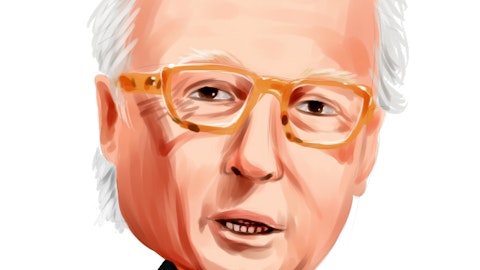Donald Hinson: Sure. I will answer that. Yes. So I think we’re going to €“ we might use a variety. We might be using €“ although we probably won’t be adding to our investment portfolio, it does draw some cash flows there. I think we will utilize possibly some borrowings. I think it’s going to be a mix of instruments we use, borrowings. Possibly, I mentioned in my prepared remarks about brokered CDs and we may sell some securities also, maybe just a variety of things to meet it. Obviously, there’s benefits to in the short run of selling securities, but I think it hurts you, in a way as long run. One of our strategies this last year was actually to become less asset sensitive as we reach the peak at the rates. So when rates come back down, then we will be protecting some margin.
So you’re going to give that up if you start selling security. So we’ll use a variety of methods to manage our liquidity, which we have a lot of with €“ again, with a loan-deposit ratio of 68%. We have plenty of room to manage this.
Eric Spector: Okay. Sounds good. Makes sense. And then you purchased some resi mortgages again this quarter. Just curious how you think about that going forward?
Donald Hinson: We’ll probably be doing some of that, but probably not to the extent we did it in 2022, but we will use it to do some supplement loan growth. In addition to, again, it’s kind of a higher duration paper. So I think we’re locking in some rates that way.
Eric Spector: Okay. Thanks. And then I just wanted to lastly just touch on capital. Stocks pulled back a little bit. How do you think about capital now going forward?
Donald Hinson: Well, currently, we’re maintaining our capital for purposes of growth. As you see, we’ve added a lot of teams, and therefore, we’re expecting a lot of production in certain areas. And so right now, our first priority is growth. There’s a chance we might be €“ we might have some buybacks, but it’s not going to be certainly a focus.
Eric Spector: Okay. Sounds good. Thank you. That’s it for me and congrats again on solid quarter.
Donald Hinson: Thanks, Eric.
Operator: Thank you, Eric. The next question is from Jeff Rulis with D.A. Davidson. Jeff?
Jeffrey Rulis: Thanks. Good morning.
Jeffrey Deuel: Good morning.
Jeffrey Rulis: Wanted to circle back to the margin. I got your comments that kind of certainly entering 2023 with some momentum, I think the industry certainly participate on the upside with earning asset yields or pricing now we’re for giving it back on the funding crunch in 2023. My guess is your €“ if you are a little more fortunate on the deposit side, I guess it’s a long way of asking, should we expect to still outpace that deposit pressure and scratch out further margin increase? I mean, I’m looking more into the balance of 2023 and what you think about margin? Thanks.
Donald Hinson: Jeff, I expect there to be some margin expansion through this year, but it will be contingent on, again, how much runoff deposits we might experience because the more runoff we have, the other actions we might need to take as far as borrowings, which are obviously cost a lot higher. And our loan growth, it would be another one. I’m expecting our loan growth to continue, which will help that. So I think those factors will be important. The third is just the overall rate environment. What happens there? Are they going to do 50 basis points and stop for a long time or will they can start coming back down? So there’s obviously a lot of factors. But in general, I do expect our margin to expand some this year, although at a much slower pace.
Jeffrey Rulis: Okay. And that sounds fairly sustained. If we looked at sort of last cycle and how you performed versus peers on a margin, it seemed like that was €“ it had more of an extended run given the deposit franchise strengths €“ that would €“ all inputs aside, that seems like a fair assumption this time around?
Donald Hinson: Yes.
Jeffrey Rulis: Okay. And then on the loan growth, I may have missed it. I think it kind of pointed to mid-single digit in Q1. Did you round that out for the balance of the year in terms of full-year growth?
Jeffrey Deuel: We did say mid-single digit, Jeff, in the text and €“ it’s just €“ it’s hard to see too far out there. Historically, we’ve said mid to high-single digits. I think in a nice €“ a more positive environment, we might see it pick up some. I think we’re also waiting to see what we’re going to get in the new year from some of these teams. But you know that we always take a pretty conservative approach on our loan growth. So that’s why you’re getting that mid-single digit.
Jeffrey Rulis: Got it. And Jeff, I €“ Don kind of answered the capital question, and I’ll circle back. I think you said we’ll continue to look at M&A and look at team ads. Any more inbounds in terms of sellers in the region? Or has it been pretty quiet?
Jeffrey Deuel: It’s still pretty quiet and has been for quite a while, as you well know. We just continue to have our conversations stay closed in the event that somebody decides to do something. But for probably the first half of next year, I don’t see much happening.
Jeffrey Rulis: Pretty quiet. Okay. Well, thank you. I’ll step back.
Jeffrey Deuel: Thank you.
Operator: Thank you, Jeff. The next question comes from the line of Andrew Terrell with Stephens. Andrew?
Andrew Terrell: Hey, good morning.
Jeffrey Deuel: Good morning.
Andrew Terrell: Apologies if I missed this in earlier comments, but did you provide the new production yields for the quarter? Just new production loan yields?
Jeffrey Deuel: Bryan, do you have that?
Bryan McDonald: Yes. Andrew, for new commercial loans, it was 5.72%, which is up from 4.87% last quarter. And then for all new loans, it was 5.51% which is up from 4.89% last quarter.
Andrew Terrell: Okay. Got it. Thank you. And then do you have a breakdown for how much of your fixed rate loans or adjustable rate loans repriced over the coming year? And then also just the amount of cash flow for the securities book. I’m just trying to get a sense for kind of overall earning asset repricing dynamics looking throughout 2023?
Jeffrey Deuel: Yes, Page 17. Go ahead, Don.
Donald Hinson: Well, Andrew, if you go to Page 29, actually, of the investor presentation talks about the repricing. So we break it up into floating rate, which is under three months. And then adjustable rate and then fixed. So you see that about 16.6% of overall assets repriced at about 22% of loans, repriced in less than three months and half of that is about prime and the other half is LIBOR. So that helps you there.
Andrew Terrell: Yes. I guess just for the €“ I’m trying to get a sense for the adjustable piece, the 17%, the fixed rate of 65%, just how much of that could have a potential rate reset higher throughout 2023, just thinking about kind of longer term, if the Fed were to pause, just thinking about maybe kind of longer term earning asset repricing benefits?
Donald Hinson: Okay. I would say just on kind of looking back €“ previously, I haven’t looked it up for this quarter, but I would say probably without that adjustable rate, probably another 20%, 30% of that is probably going to reprice this year.




